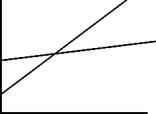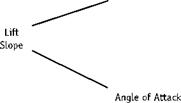Second Story
What happens if we magnify the formalism? It depends on what we choose to magnify and where we look. I’ll magnify it in various ways in the course of this chapter, but let me start with the term left hanging earlier, that of lift slope. We already know something about lift slope. We know that it is related to, but different from, gust response and the other terms in the formalism. But outside the formalism, the term is idle. It is a short cut. It doesn’t tell us anything. So what do we discover if we magnify it?
The answer is that it decomposes. It turns from a single term into a relation between two further terms. So this is another difference, another specified difference. And the new terms? These are lift and angle of attack.
Some definitions.
—Lift is the lifting force of a wing as it moves through the air. In engineering this is usually written CL.
—Angle of attack, written a, is (roughly) the angle between the wing and the air through which it is traveling (figure 5.1).
|
FIGURE 5.1 Relationship between Angle of Attack and Lift. If the increase in lift with increase in angle of attack is small, then lift curve slope is low.
|
—And lift slope? This is the slope of the curve that links lift and speed for a given wing if they are laid out as the two coordinates of a graph (see figure 5.2).
All of this means that if lift slope is low then as the angle of attack alters, lift doesn’t change much and the curve is flattish; if lift slope is high then lift changes more and the curve is steeper.
|
|
|
|
|
|
|
|
|
|
|
|
|
|
|
|
|
|

![]()
Heterogeneity/Simplicity
If we magnify the term ‘‘lift slope’’ in this way then we introduce a further set of differences. We might write them into equation (1) to produce something like this:
velocity x (change in lift coefficient/
change in angle of attack) M-(dCL/da)
aircraft weight/wing area W/S
We might work at this formalism to rearrange its terms and simplify it a little, but let’s make another point. This new formalism is more complicated than the old one though it’s not unmanageable, at least not yet. But if we were to expand the other terms—for instance unpacking the calculations that lead to Mach number, M—it would grow still further. And it could be expanded in other directions too.
What might we make of this? One answer is that design is all about distributing relations, relations of difference, but that only some of those relations are relations of presence. Only some of them crop up together on the page. And the corollary? This formalism performs many other relations. It also makes relations of absence. In one way or
another, and for one reason or another, there are limits to the relations made present.
So what might the character of these absences be? The answer, or so I want to suggest, is that there are several logics of absence or alterity. I will point to some of these shortly. But, looking at the formalism above, don’t we see a straightforward and immediate version of the logic of absence? This is the fact that it is easier to handle formalisms with fewer terms than those with more (though the same logic applies just as well to nonformalisms). So this, perhaps, is a basic design principle, a basic feature of the character of making simplicities—that present complexity is self-limiting (see Strathern 1991).
Perhaps we might call this heterogeneity/simplicity. Put the “heterogeneity” on one side for the moment: I’ll come back to this shortly. By ‘‘simplicity’’ I mean, straightforwardly, that there is not enough room for everything. That not everything can crowd into a single place. That implosion, or perhaps better condensation, is impracticable. Not possible. Perhaps this is a general principle. But, linked to a concern with centering and singularity, it’s what the actor-network theorists point to when they tell of ‘‘punctualization.’’4 Complicated things come in simple packages; they are ‘‘black boxed’’ by such terms as lift slope, which can be used to make sense.












